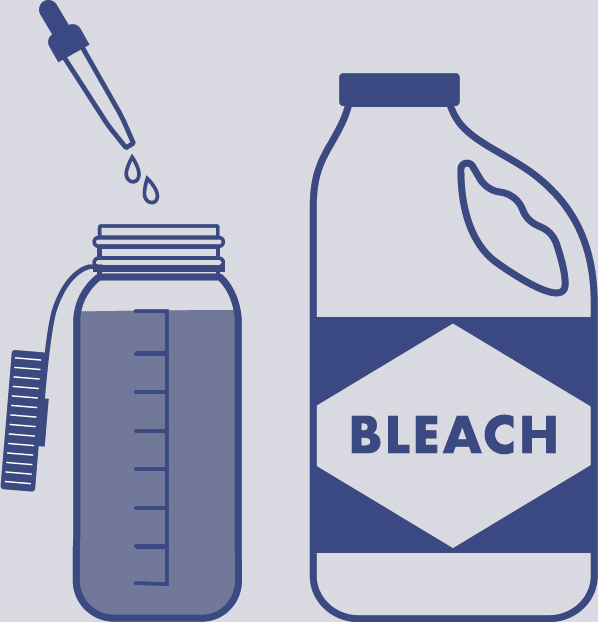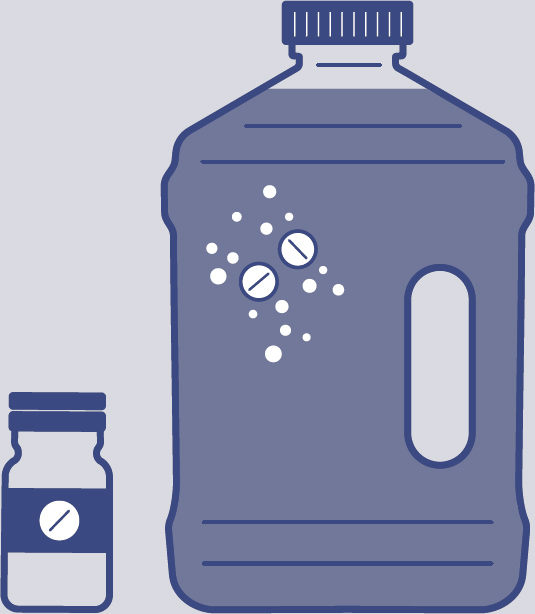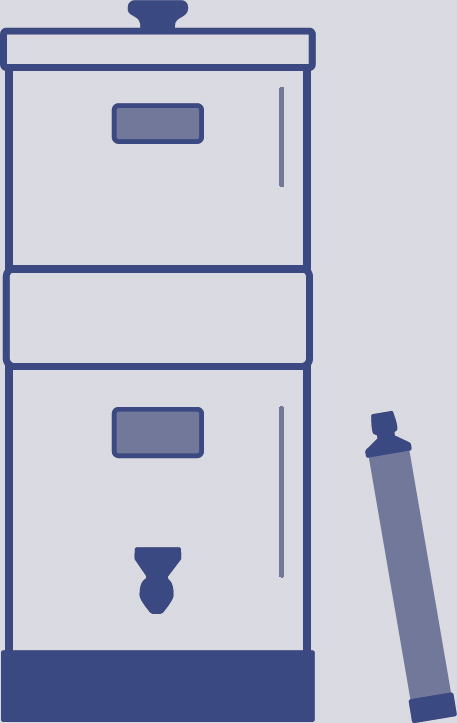FOUR
BEFORE THE TAP IS DRY: WATER NOW
Following a mega-earthquake, having a supply of clean water is the most critical need you’ll have. If you do only one thing to prepare for the Cascadia earthquake, it should be making sure you have 1 gallon of potable water per day for each household member, for two weeks—14 gallons of water per person total. Without that, you risk illness (and even death) from dehydration or drinking contaminated water.
Additionally, you’ll want to have water for your animals: pets need about an ounce per pound of weight per day; store double this amount to account for spillage from pet water dishes during aftershocks.
You can find descriptions of more exotic ways to get water, such as solar stills and condensation catchers, in any wilderness survival book. This chapter covers the options that are practical for most people.
CHALLENGES OF STORING WATER
Here’s the problem: water is heavy and bulky—1 gallon of water weighs more than 8 pounds. It’s a hassle to lug it around and put it away, it’s a chore to figure out where to store it, and it is boring; few people get even a tiny spark of excitement from buying and storing water. If it leaks, you risk ruined floors or moldy messes. And if all that isn’t enough, many people operate under the mistaken belief that commercially bottled water expires, meaning they have to frequently rotate the water they buy. While the containers commercially bottled water comes in can degrade and leak depending on storage conditions, this will usually not happen until years after the expiration date stamped on the container.
It’s easy to see why people delay storing water in favor of collecting more interesting or easy-to-store preparedness supplies, but it’s the single most important preparation you can do, so don’t put it off any longer. Find the best way for your household to keep water, and get it stocked and stashed as soon as possible.
SAFEST COMMERCIALLY AVAILABLE WATER SOURCES
One of the easiest ways to store emergency drinking water is to purchase canned or bottled water. Since it’s already packaged, it’s just a matter of choosing an option and then storing it away.
EMERGENCY CANNED WATER
The key advantage to canned emergency water is that it is easy to store and needs to be rotated only every four to five decades, which makes up for its higher cost (see the chart on this page for a cost comparison). Cases of the water can be easily stored under a bed, stacked in the back of cabinets, or layered across a closet floor.
The main disadvantage is that you can’t store the cans anywhere they might freeze or stack so much weight on them that the cans are stressed or burst. And the price tag is another—but there’s no clear evidence that water sold specifically for emergencies and marketed as “extra-pure” is any different or longer lasting than standard canned seltzer water.
NONEMERGENCY CANNED SELTZER WATER OR CLUB SODA
Most large grocery chains offer a house brand of canned club soda or seltzer water that is simply carbonated water without additives, sodium, flavorings, or anything else that could degrade over time and contaminate the water or damage the can. These options are a much less expensive alternative to canned emergency water, but like canned emergency water, the cans can’t be stored anywhere they might freeze.
You can use canned seltzer water or club soda for cooking rice, oatmeal, or other heated meals and the bubbles will disappear during cooking. Of course, you can also drink it as carbonated water. For some people, too much carbonated water can cause digestive distress, but if you open a can and leave it out, the carbonation will go flat in about twenty-six hours—if it hasn’t already done so in storage, since the bubbles dissipate over time.
COMMERCIALI/BOTTLED WATER IN ALUMINUM CONTAINERS
Though expensive, commercially bottled water in aluminum containers is worth considering for the durability and usefulness of the containers: namely, they have caps. Aftershocks will spill uncovered water—such as opened cans—resulting in lost supplies. These aluminum bottles are also easily carried, increasing the likelihood that people will drink more often and stay well hydrated. Finally, unlike plastic water bottles, they are sturdy, reusable many times, easy to clean, and able to hold warm liquids as well as cold. While manufacturers make no claims regarding long-term storage, this type of container will probably last at least ten to twenty years.
COMMERCIALLY BOTTLED WATER IN PLASTIC CONTAINERS
Commercially bottled water comes in a large variety of plastic containers, from single-serving size to 5-gallon water dispenser jugs. It is the most affordable choice for purchasing water, but has a downside: upkeep.
Commercially bottled water carries an “expiration date.” The Food and Drug Administration, the federal agency responsible for the safety of bottled water, states unequivocally that water does not expire. But the plastic containers the water comes in will degrade over time. Mostly this won’t make the water unsafe, though it may taste stale; pour it back and forth between two containers to add oxygen and freshen the taste. However, leaks can allow the water to become contaminated, and storing bottled water near chemicals, pet litter boxes, or stored gasoline means fumes can pass into the container, affecting the taste and/or safety of the water.
Generally, smaller plastic containers degrade more quickly than larger ones. Plastic jugs like gallon milk jugs will break down more quickly than the more rigid clear plastic gallon containers, but may last four years or more if stored in a cool basement—though much less when stored in extreme temperatures in a garage or attic. Anything smaller is made of plastic that breaks down more quickly. If your family regularly drinks bottled water, having smaller containers may work for you; otherwise, you’ll need to check those smaller containers at least twice a year.
COMPARISON OF COMMERCIALLY CANNED OR BOTTLED WATER
Type of Container |
Cost* |
10 to 22 cents/ounce |
|
Approximately 2 cents/ounce |
|
Commercially bottled water in plastic containers |
Approximately 1 cent/ounce |
9 to 14 cents/ounce |
*Prices approximate, to give an idea of differences between options. Spikes in demand may impact prices and supply.
SAFEST HOUSEHOLD WATER SOURCES
You already have sources of emergency water in your home, though you need to have the supplies necessary to take advantage of these water sources—to access and purify it. Have a look through this list and figure out what will be a feasible way for your family to access water following an earthquake.
WATER HEATER
Even though you will use the in-house shutoff to stop water coming into your home as soon as possible after a mega-earthquake, you will still have 40 to 50 gallons of usable water in your typical water heater. You won’t know for sure whether this water has been contaminated, so be safe and purify it (see this page).
To access the water, you’ll need a coupling and hose that fit on your water heater to drain it—ask a local plumbing shop or home improvement store if you’re unsure what you need. Also be sure to have clean containers ready for storing the water, as you will want to drain all the water at once to avoid having to reenter and reaccess the water heater during or following aftershocks. An average-sized water heater will require approximately nine containers holding 5 gallons each, with lids, or twenty collapsible 2-gallon containers; ideally, find containers with volume markers to make it easier to measure and purify the water. Water weighs about 8 pounds per gallon, so using the larger containers means you’ll need someone who can carry 40 pounds to move just one of the larger containers.
TOILET TANK
Another household reservoir of water is your toilet tank (not bowl!). Store a regular or collapsible 1-gallon water container under your bathroom sink to hold water from the toilet tank. To get the water out of the tank, cut a clean liter plastic bottle in half—the top half acts as a funnel, and the bottom half is a scooping cup you can use to fill the storage container. Keep this liter plastic bottle clean in a sealed bag stored under the sink, along with instructions for purifying the water (this page).
SELF-STORED WATER IN THE FREEZER
Freezers work best when they are filled. If you have extra space in your freezer, store plastic containers of water. Fill containers only 85 percent full to leave space for expansion so the container doesn’t burst.
SELF-BOTTLED WATER
If you have more time than money, you can self-bottle small amounts of emergency water in empty 2-liter plastic soda containers (for safety, use only soda containers since they can be sanitized completely).
You can also self-bottle water using larger containers manufactured for this purpose. Water bricks, commercially available products made of heavy plastic, are stackable, maximizing storage. They hold 1.5 to 3.5 gallons each. Two- to 7-gallon opaque containers sold to store water are easily filled and stored if you have space, and you can even buy 25- to 100-gallon barrels to store water. For these larger containers, you’ll need to consider how to secure them, since a Cascadia earthquake could knock them over, as well as purchase spigots and/or pumps to get the water out.
You will have to empty and refill these self-bottled containers every six months, since self-bottled water is more at risk for bacteria and algae growth. In larger containers, you can purchase and use water preserver which will extend the life to five years. If you refill your containers every six months, you can use the stored water in the garden when you rotate it out, or if the water is stored in opaque containers, eliminating the growth of algae, you could simply purify the water when you need to use it, rather than rotating it.
HOW TO STERILIZE REUSABLE CONTAINERS
Wash the container with warm water—and only a tiny bit of dish soap. Rinse well.
Make a solution of one-quarter teaspoon of bleach and 1 gallon of water and fill the first container, swishing the solution around inside and pouring it over the neck to completely sterilize it.
Pour the solution out into another washed container and repeat the process until all containers are sterilized.
If your water comes from a municipal or other treated source, fill the containers with tap water, cap, and store in a cool, dark place.
If you are on well water, add 10 drops of unscented bleach with no additives to each container before storing it.
HIGHER-RISK WATER SOURCES
Household water filters like Brita will be of no help; camping-style water filters such as a LifeStraw can eliminate bacteria but can’t remove chemical contaminants. Boiling the water can concentrate some contaminates, and treating water with bleach won’t eliminate gasoline or other chemicals in the water. See the sidebar on purifying water at the end of this chapter (this page).
RAIN-BARREL WATER
Water collected from metal roofs may have bacteria from animal waste, so purify the water. Water collected from asphalt roofs may contain heavy metals from the shingles and boiling water would only concentrate these contaminants, so avoid using it for drinking or cooking.
NATURAL WATER SOURCES
Anything near a natural water source—the contents of homes, chemicals from businesses, fuel from cars and trucks—may be shaken into the water during an earthquake, and aftershocks will mean additional contaminants in the water. Densely populated urban areas will have thousands of sources of possible contamination, but even in rural areas, just one tank of fertilizer, pesticide, or gasoline spilled into a waterway will create problems.
You can assume that any contamination will spread farther and may get worse as time goes on. If you plan to use a natural water source after the earthquake, you’ll need to get as much water as possible into containers as soon as possible. You won’t have any way of knowing what is in the water or whether standard purification methods will make the water safe. Water testing kits that are available online won’t cover all dangers, but they will help you determine whether the water has common contaminants.
For natural water sources, no matter how careful you are, there will still be a risk in drinking water from lakes, rivers, or streams. Water from human-made lakes and ponds usually has high concentrations of pesticides. Don’t drink it.
WAYS TO PURIFY WATER FROM SAFE AND HIGHER-RISK SOURCES
No matter which purification method you use, start by letting the water stand until particles settle, then pour off the clear water into a clean container and use one of the following methods to purify it.
Treating with Bleach
Add two drops of unscented bleach (no additives!) for each quart of water (eight drops for each gallon of water). If the water is visibly cloudy, double the amount of bleach. (Or use water purification tablets per package directions.)
Let stand twenty minutes.
Water should now have a slight chlorine smell. If not, repeat the process.
To reduce the chlorine smell, if desired, pour the water back and forth between two clean containers.
Boiling
Bring water to a full boil and keep it at a full boil for one minute.
Filtering
Use a high-quality water filter, such as a LifeStraw or Berkey, which removes viruses and bacteria. Your regular Brita-type water-pitcher filter is not designed for disaster use, and lack of regulation means that cheaper camping filters may not do any good.
WAYS TO PURIFY WATER

Bleach
Add 2 drops of unscented bleach (no additives) for each quart of water, or 8 drops for each gallon.

Boil
Bring water to a full boil for one minute.

Tablets
Follow package instructions for water purification tablets.

Filter
Only use high-quality water filters such as LifeStraw or Berkey.
WATER CHECKLIST
Water from swimming pools and hot tubs contains chemicals that can make you sick, so it should not be used for drinking or cooking. The water in water beds has fungicides and other chemicals that are dangerous if ingested. You may want to use the water from these nonpotable sources for other purposes, including hygiene and sanitation—see those chapters for more information. Water from these unsafe sources can also be used for dousing or fighting small fires.
NECESSARY
□ 1 gallon of water per person per day for fourteen days (56 gallons for a family of four)
□ Water for pets, chickens, livestock
□ A hose and coupling that attaches to the water heater spigot to drain it
□ A spigot and pump to empty 25- to 100-gallon water containers, if using
□ A container of bleach with no additives or fragrance (bleach expires; you need to rotate it)
□ Alternatively, water purification tablets or fuel to boil water
□ Empty, clean water containers with lids
NICE TO HAVE
□ Wagon, golf cart, bike trailer, sturdy stroller, shopping cart, hard-sided suitcase, or skateboard to move heavy containers of water
□ A LifeStraw or other high-quality water filter, in individual or family size; include in go-bag (see Chapter Five) and/or at home
